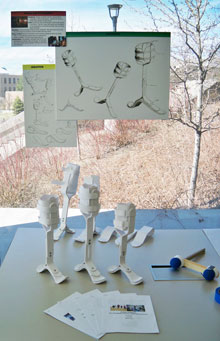
Kirk Chadwick’s low-cost prosthetic leg is one of five prototypes being considered for further development. Photograph courtesy of Kirk Chadwick.
The Interdisciplinary Design program at the University of Utah (U of U), Salt Lake City, is allowing some of its students to master the finer points of industrial design, while trying to make a difference in the lives of others. In this case, it is designing prosthetic legs.
Theodore Espiritu, associate instructor with the U of U School of Architecture, College of Architecture and Planning, has challenged his students to design inexpensive prosthetic legs for developing and third-world countries. The students are trying to design alternatives that would cost between $100 and $200.
The materials need to be sturdy, but be able to absorb shock as well, said Espirtu. They’ve tried plastics and even wood. The class started with students designing 18 concepts, which have been narrowed to five prototypes. A final concept will then go through the Technology Commercialization Office, which will eventually lead to a patented and marketed product.
Barrett Yates, a senior in bioengineering, said some of the challenges included making a product that is light and durable, but that was also made of cheap materials that are easily obtainable and have an inexpensive manufacturing process.
While much of the class is focused on researching building materials and the manufacturing process, the students also had to research different cultures and the situation of developing countries. “Cost is a major issue, but we need to consider aesthetics as well, to make sure it culturally fits,” said Yates. “We look at functionality, so that…[the prosthesis provides users with] a natural walking gait.”




